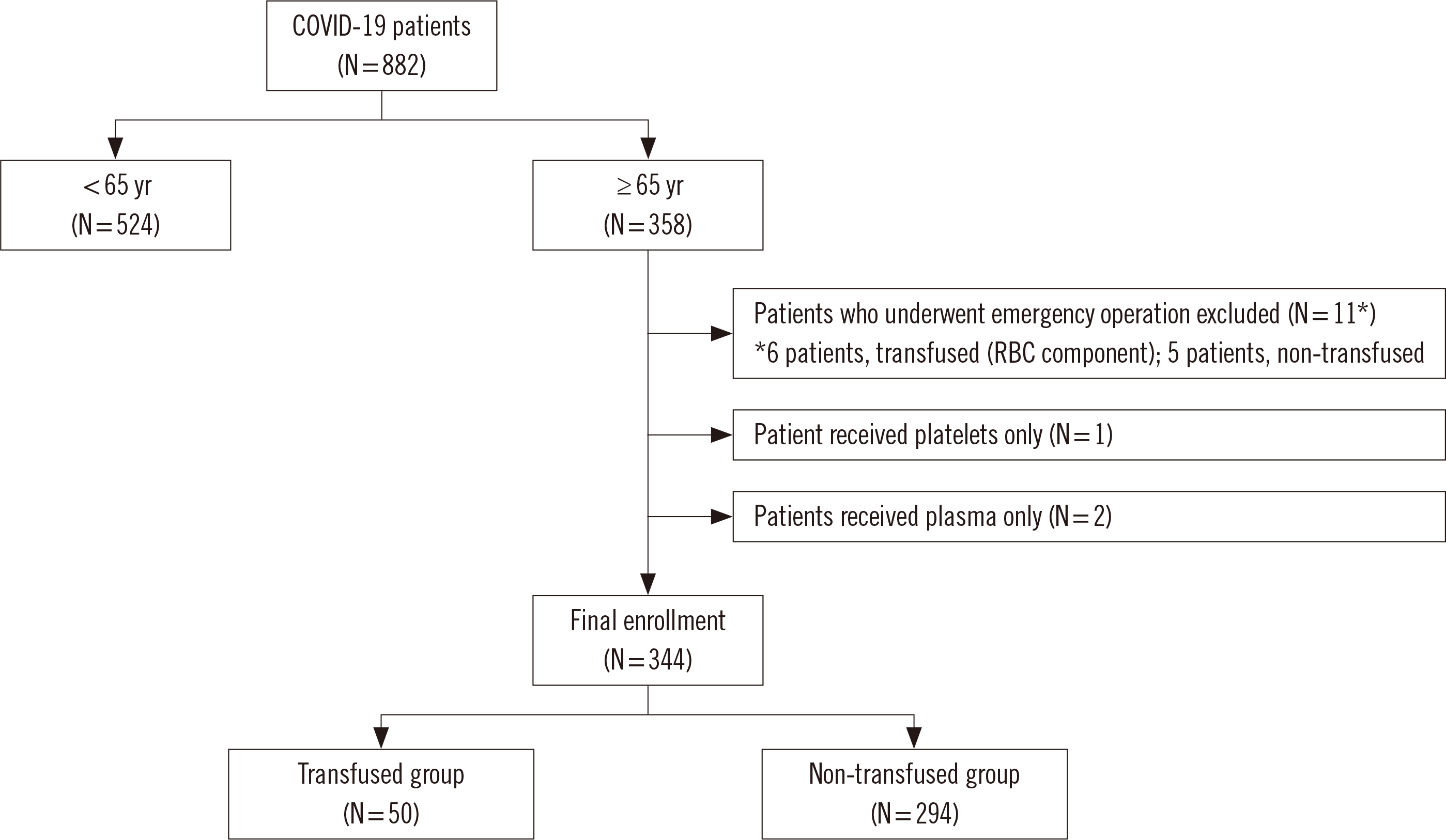3. Pagano MB, Hess JR, Tsang HC, Staley E, Gernsheimer T, Sen N, et al. 2020; Prepare to adapt: blood supply and transfusion support during the first 2 weeks of the 2019 novel coronavirus (COVID-19) pandemic affecting Washington State. Transfusion. 60:908–11. DOI:
10.1111/trf.15789. PMID:
32198754.

6. Thachil J, Tang N, Gando S, Falanga A, Cattaneo M, Levi M, et al. 2020; ISTH interim guidance on recognition and management of coagulopathy in COVID-19. J Thromb Haemost. 18:1023–6. DOI:
10.1111/jth.14810. PMID:
32338827.

7. Barriteau CM, Bochey P, Lindholm PF, Hartman K, Sumugod R, Ramsey G. 2020; Blood transfusion utilization in hospitalized COVID-19 patients. Transfusion. 60:1919–23. DOI:
10.1111/trf.15947. PMID:
32583506. PMCID:
PMC7361376.
8. DeSimone RA, Costa VA, Kane K, Sepulveda JL, Ellsworth GB, Gulick RM, et al. 2021; Blood component utilization in COVID-19 patients in New York City: transfusions do not follow the curve. Transfusion. 61:692–8. DOI:
10.1111/trf.16202. PMID:
33215718. PMCID:
PMC7753518.

9. Doyle AJ, Danaee A, Furtado CI, Miller S, Maggs T, Robinson SE, et al. 2020; Blood component use in critical care in patients with COVID-19 infection: a single-centre experience. Br J Haematol. 191:382–5. DOI:
10.1111/bjh.17007. PMID:
32640484. PMCID:
PMC7362152.

10. Fan BE, Ong KH, Chan SSW, Young BE, Chong VCL, Chen SPC, et al. 2020; Blood and blood product use during COVID-19 infection. Am J Hematol. 95:E158–60. DOI:
10.1002/ajh.25823. PMID:
32279352. PMCID:
PMC7262362.
11. Pagano MB, Cataife G, Fertrin KY, Gernsheimer T, Hess JR, Staley E, et al. 2020; Blood use and transfusion needs at a large health care system in Washington state during the SARS-CoV-2 pandemic. Transfusion. 60:2859–66. DOI:
10.1111/trf.16051. PMID:
32856307.

12. Rim JH, Lee SA, Han CH, Yoo J. 2020; Transfusion demand in COVID-19 patients from the Korean population: a nationwide study in South Korea. Br J Haematol. 190:e323–6. DOI:
10.1111/bjh.17030. PMID:
32677031. PMCID:
PMC7404952.

13. Velázquez-Kennedy K, Luna A, Sánchez-Tornero A, Jiménez-Chillón C, Jiménez-Martín A, Vallés Carboneras A, et al. 2021; Transfusion support in COVID-19 patients: impact on hospital blood component supply during the outbreak. Transfusion. 61:361–7. DOI:
10.1111/trf.16171. PMID:
33146420.

14. Hernández-Maraver D, Viejo A, Kerguelén AE, Jiménez-Yuste V. 2020; Transfusion medicine during COVID-19 outbreak in the hotspot of Spain. Transfusion. 60:2762–4. DOI:
10.1111/trf.16038. PMID:
32815162. PMCID:
PMC7461430.

15. Fagard K, Gielen E, Deschodt M, Devriendt E, Flamaing J. 2021; Risk factors for severe COVID-19 disease and death in patients aged 70 and over: a retrospective observational cohort study. Acta Clin Belg. 21:1–8. DOI:
10.21203/rs.3.rs-101387/v1. PMID:
33616021.

16. Gao YD, Ding M, Dong X, Zhang JJ, Kursat Azkur A, Azkur D, et al. 2021; Risk factors for severe and critically ill COVID-19 patients: a review. Allergy. 76:428–55. DOI:
10.1111/all.14657. PMID:
33185910.

17. Sung HK, Kim JY, Heo J, Seo H, Jang YS, Kim H, et al. 2020; Clinical course and outcomes of 3,060 patients with coronavirus disease 2019 in Korea, January-May 2020. J Korean Med Sci. 35:e280. DOI:
10.3346/jkms.2020.35.e280. PMID:
32743995. PMCID:
PMC7402927.

18. Sanyaolu A, Okorie C, Marinkovic A, Patidar R, Younis K, Desai P, et al. 2020; Comorbidity and its impact on patients with COVID-19. SN Compr Clin Med. 2:1069–76. DOI:
10.1007/s42399-020-00363-4. PMID:
32838147. PMCID:
PMC7314621.

19. WHO Working Group on the Clinical Characterisation and Management of COVID-19 infection. 2020; A minimal common outcome measure set for COVID-19 clinical research. Lancet Infect Dis. 20:e192–7. DOI:
10.1016/s1473-3099(20)30483-7. PMID:
32539990. PMCID:
PMC7292605.
20. Kim Y, Sung HK, Bang JH, Koh IS, Joh JS, Ju YS, et al. 2020; Letter to Editor: Strategy for hospitalization and discharge of COVID-19 patients: based on the nationwide clinical course analysis. J Korean Med Sci. 35:e353. DOI:
10.3346/jkms.2020.35.e353. PMID:
32989937. PMCID:
PMC7521957.

21. Terpos E, Ntanasis-Stathopoulos I, Elalamy I, Kastritis E, Sergentanis TN, Politou M, et al. 2020; Hematological findings and complications of COVID-19. Am J Hematol. 95:834–47. DOI:
10.1002/ajh.25829. PMID:
32282949. PMCID:
PMC7262337.

22. Sanz C, Faundez A, García Carulla A, Rodriguez Aliberas M, Coromoto A, Pereira A. 2020; Hemorrhage is a major cause of blood transfusion in COVID-19 patients. Blood. 136:21–2. DOI:
10.1182/blood-2020-138830. PMCID:
PMC8330354.

25. Petrilli CM, Jones SA, Yang J, Rajagopalan H, O'Donnell L, Chernyak Y, et al. 2020; Factors associated with hospital admission and critical illness among 5279 people with coronavirus disease 2019 in New York City: prospective cohort study. BMJ. 369:m1966. DOI:
10.1136/bmj.m1966. PMID:
32444366. PMCID:
PMC7243801.

26. Guo L, Shi Z, Zhang Y, Wang C, Do Vale Moreira NC, Zuo H, et al. 2020; Comorbid diabetes and the risk of disease severity or death among 8807 COVID-19 patients in China: a meta-analysis. Diabetes Res Clin Pract. 166:108346. DOI:
10.1016/j.diabres.2020.108346. PMID:
32710998. PMCID:
PMC7375287.

27. Dalmazzo LFF, de Almendra Freitas AF, Alves BE, Cardoso DK, de Carvalho EF, Akil F, et al. 2021; Transfusion profile, clinical characteristics, comorbidities and outcomes of 3014 hospitalized patients diagnosed with COVID-19 in Brazil. Vox Sang. 116:983–9. DOI:
10.1111/vox.13087. PMID:
33634890. PMCID:
PMC8014314.

28. Li X, Liu C, Mao Z, Xiao M, Wang L, Qi S, et al. 2020; Predictive values of neutrophil-to-lymphocyte ratio on disease severity and mortality in COVID-19 patients: a systematic review and meta-analysis. Crit Care. 24:647. DOI:
10.1186/s13054-020-03374-8. PMID:
33198786. PMCID:
PMC7667659.

29. Simadibrata DM, Calvin J, Wijaya AD, Ibrahim NAA. 2021; Neutrophil-to-lymphocyte ratio on admission to predict the severity and mortality of COVID-19 patients: a meta-analysis. Am J Emerg Med. 42:60–9. DOI:
10.1016/j.ajem.2021.01.006. PMID:
33453617. PMCID:
PMC7832118.

30. Salehi S, Abedi A, Balakrishnan S, Gholamrezanezhad A. 2020; Coronavirus disease 2019 (COVID-19): a systematic review of imaging findings in 919 patients. AJR Am J Roentgenol. 215:87–93. DOI:
10.2214/AJR.20.23034. PMID:
32174129.

31. Huang C, Wang Y, Li X, Ren L, Zhao J, Hu Y, et al. 2020; Clinical features of patients infected with 2019 novel coronavirus in Wuhan, China. Lancet. 395:497–506. DOI:
10.1016/S0140-6736(20)30183-5. PMID:
31986264. PMCID:
PMC7159299.





 PDF
PDF Citation
Citation Print
Print




 XML Download
XML Download